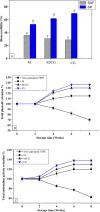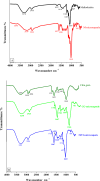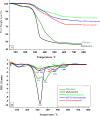Microencapsulation of antioxidant phenolics from tamarind seed peels using chia gum and maltodextrin
- PMID: 40000724
- PMCID: PMC11861649
- DOI: 10.1038/s41598-025-89792-6
Microencapsulation of antioxidant phenolics from tamarind seed peels using chia gum and maltodextrin
Abstract
Tamarindus indica seeds/seed peels (TSP) are the main waste products from the tamarind industry and contain valuable bioactive antioxidant-phenolic compounds that promote human health; however, their application is limited due to their instability and poor solubility. Encapsulation is becoming more important in several industries due to its potential for preserving and delivering valuable and delicate bioactive compounds. This study targets the microencapsulation of TSP-phenolic compounds for incorporation into functional food formulations. By employing the freeze-drying method, three microcapsule formulations were developed using chia gum (CG), maltodextrin (M), and a mixture of the two (M/CG) as coating materials. The formed M-, M/CG-, and CG-microcapsules showed remarkable encapsulation efficiency of 88.0, 90.0, and 95.0%, respectively. They preserved most of the TSP-phenolic content (87.5-96.3%) and antioxidant activity (86.0-98.8%). They demonstrated higher digestibility percentages in the intestinal media (53.0-70.0%) than in the gastric media (29.0-36.0%), especially the microcapsules coated with CG. They kept the TSP-antioxidant-phenolic content safe at 40 °C for 2 months. The microcapsules demonstrated improved microstructures, swelling, solubility, and moisture content. Crosslinking and enhanced thermal stability were also proven for microcapsules via FTIR and thermogravimetric studies. In addition, the prepared microcapsules displayed better antimicrobial activity against the examined bacterial strains, with minimum bactericidal concentrations ranging from 0.61 to 1.4 mg/mL. In conclusion, the encapsulation improved the stability, bioavailability, and antibacterial properties of TSP-phenolic compounds, making them suitable for food and pharmaceutical applications.
Keywords: Tamarindus indica; Bioavailability; Encapsulation; Peels; Phenolic compounds; Stability.
© 2025. The Author(s).
Conflict of interest statement
Declarations. Conflict of interest: the authors state that there are no conflicts of interest to disclose.
Figures




Similar articles
-
Chia gum-gelatin-based encapsulation of chia sprouts phenolic compounds enhanced storage stability, bioavailability, antioxidant, antidiabetic, and antibacterial properties.Sci Rep. 2024 Sep 25;14(1):22023. doi: 10.1038/s41598-024-71913-2. Sci Rep. 2024. PMID: 39322745 Free PMC article.
-
Microencapsulation of Saffron Petal Phenolic Extract: Their Characterization, In Vitro Gastrointestinal Digestion, and Storage Stability.J Food Sci. 2019 Oct;84(10):2745-2757. doi: 10.1111/1750-3841.14807. Epub 2019 Sep 23. J Food Sci. 2019. PMID: 31546290
-
Spray drying encapsulation of stevia extract with maltodextrin and evaluation of the physicochemical and functional properties of produced powders.J Food Sci. 2020 Oct;85(10):3590-3600. doi: 10.1111/1750-3841.15437. Epub 2020 Sep 5. J Food Sci. 2020. PMID: 32888354
-
Tamarind (Tamarindus indica L.) Seed Polysaccharide: A promising biopolymer for drug delivery, wound healing, tissue engineering and beyond.Carbohydr Res. 2025 Jun;552:109454. doi: 10.1016/j.carres.2025.109454. Epub 2025 Mar 4. Carbohydr Res. 2025. PMID: 40056791 Review.
-
State-of-the-art progress on tamarind seed polysaccharide (Tamarindus indica) and its diverse potential applications, a review with insight.Carbohydr Polym. 2024 May 1;331:121847. doi: 10.1016/j.carbpol.2024.121847. Epub 2024 Feb 1. Carbohydr Polym. 2024. PMID: 38388032 Review.
Cited by
-
Encapsulation of polyphenol rich extract from rambutan (Nephelium lappaceum L.) peel for application as dual functional ingredient in ice cream.Sci Rep. 2025 Aug 20;15(1):30564. doi: 10.1038/s41598-025-06362-6. Sci Rep. 2025. PMID: 40835627
References
-
- Abdel-Aty, A. M., Barakat, A. Z., Bassuiny, R. I. & Mohamed, S. A. Antioxidant-polyphenols of saw palmetto seeds: Statistical optimized production and improved functional properties under solid-state fermentation by Trichoderma reesei. J. Food Meas. Charact.17, 1132–1143 (2023).
-
- Barakat, A. Z., Hamed, A. R., Bassuiny, R. I., Abdel-Aty, A. M. & Mohamed, S. A. Date palm and saw palmetto seeds functional properties: Antioxidant, anti-inflammatory and antimicrobial activities. J. Food Meas. Charact.14, 1064–1072 (2020).
-
- Barakat, A. Z., Bassuiny, R. I., Abdel-Aty, A. M. & Mohamed, S. A. Diabetic complications and oxidative stress: The role of phenolic-rich extracts of saw palmetto and date palm seeds. J. Food Biochem.44, e13416 (2020). - PubMed
-
- Abdel-Aty, A. M. et al. Ficus carica, Ficus sycomorus and Euphorbia tirucalli latex extracts: Phytochemical screening, antioxidant and cytotoxic properties. Biocatal. Agric. Biotechnol.20, 101199 (2019).
MeSH terms
Substances
LinkOut - more resources
Full Text Sources
Medical
Molecular Biology Databases
Miscellaneous

